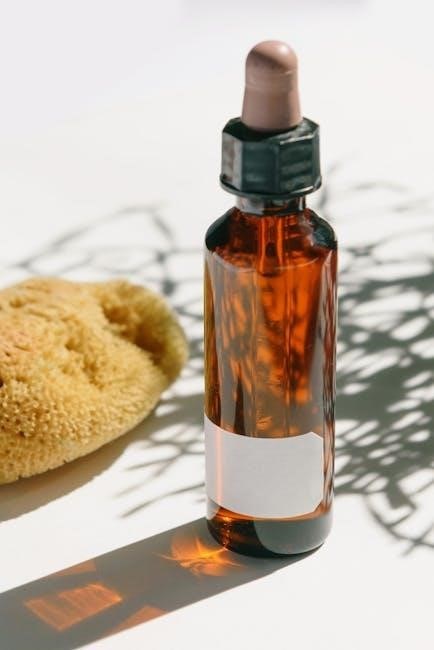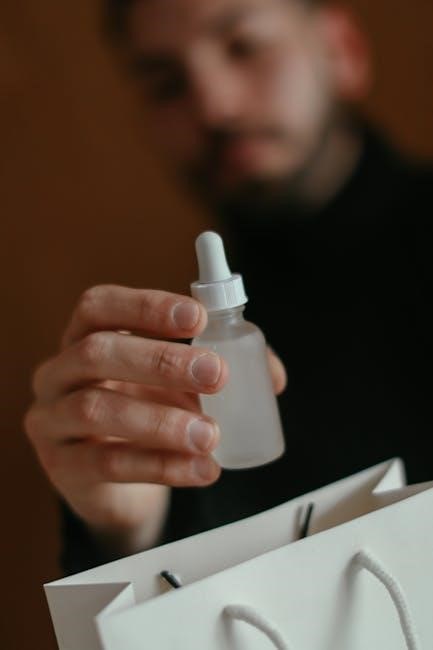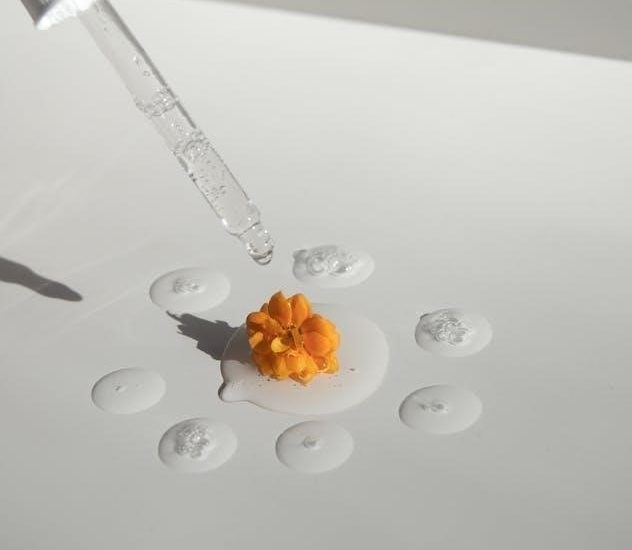Essential oils are concentrated plant extracts, offering versatile uses in aromatherapy, skincare, and natural remedies. This guide explores their benefits, from mood enhancement to physical well-being, providing practical applications for everyday life.
1.1. What Are Essential Oils?
Essential oils are highly concentrated plant extracts, typically obtained through steam distillation, cold pressing, or solvent extraction. They capture the natural scent and essence of plants, offering potent aromatic and therapeutic properties. Often referred to as the “lifeblood” of plants, these oils are used in aromatherapy, skincare, and natural remedies. Their versatility allows them to enhance mood, promote relaxation, and support physical well-being. With their strong potency, essential oils are often diluted with carrier oils for safe application. They are a natural and holistic way to incorporate the benefits of plants into daily life.
1.2. History and Evolution of Essential Oil Use
Essential oils have been used for thousands of years, dating back to ancient civilizations in Egypt, China, and Rome. They were valued for their aromatic, medicinal, and spiritual properties. Early uses included religious ceremonies, healing rituals, and perfumery. The Egyptians, for instance, used cedarwood and myrrh for mummification and spiritual practices. In traditional Chinese medicine, essential oils were incorporated for their therapeutic benefits. The Greeks and Romans later adopted these practices, using oils like lavender and rosemary for relaxation and hygiene. Over time, advancements in distillation techniques refined their production, leading to modern aromatherapy, which emphasizes their holistic benefits for mind, body, and spirit.
1.3. Why Essential Oils Are Popular Today
Essential oils have gained immense popularity due to their versatility and natural health benefits. In a world seeking holistic wellness, they offer a chemical-free alternative for improving physical, emotional, and mental well-being. Their ability to enhance mood, reduce stress, and promote relaxation resonates with modern lifestyles. Additionally, their use in skincare, household cleaning, and aromatherapy makes them a practical choice for everyday needs. As people gravitate toward natural and sustainable solutions, essential oils provide a timeless, effective, and enjoyable way to elevate health and living spaces, making them a staple in many homes and wellness routines globally.

Popular Essential Oils and Their Uses
Discover the diverse world of essential oils, from lavender to peppermint, each offering unique benefits for aromatherapy, skincare, and natural remedies, enhancing well-being and daily routines.
2.1. Lavender Oil: Benefits and Uses
Lavender oil is renowned for its calming and relaxing properties, promoting peaceful sleep and reducing stress. It is widely used in aromatherapy to create a soothing atmosphere, ideal for unwinding after a long day. Lavender oil also has skincare benefits, helping to soothe burns, acne, and minor wounds due to its antiseptic and anti-inflammatory properties. Additionally, it can be added to bathwater for a calming soak or used in massage oils to ease muscle tension. Its gentle nature makes it suitable for all skin types, including sensitive skin, and it blends well with oils like bergamot and frankincense for enhanced effects.
2.2. Peppermint Oil: Benefits and Uses
Peppermint oil is known for its invigorating and refreshing properties, offering a cooling sensation that uplifts the mind and body. It is commonly used to enhance mental clarity and focus, making it ideal for study or work sessions. Peppermint oil also provides natural relief from headaches, muscle tension, and digestive discomfort when applied topically or inhaled. Its cooling effect can soothe sore muscles and joints, while its aroma freshens the air and boosts energy levels. Additionally, it is often used in homemade cleaning products for its deodorizing properties and can be added to showers for an invigorating morning boost.
2.3. Tea Tree Oil: Benefits and Uses
Tea tree oil, known for its potent antimicrobial properties, is a popular natural remedy for various health and skincare needs. It effectively treats acne, minor wounds, and fungal infections due to its ability to combat bacteria and fungi. Tea tree oil also soothes insect bites and reduces inflammation, making it a versatile first-aid solution. In aromatherapy, it purifies the air and promotes a clean, fresh environment. Additionally, it is used in household cleaning products for its natural disinfectant qualities, providing a chemical-free alternative for maintaining a hygienic home without harsh chemicals.
2.4. Lemon Oil: Benefits and Uses
Lemon essential oil, with its bright citrus scent, is renowned for its uplifting and refreshing properties. It naturally enhances mood, reduces stress, and boosts energy levels. Lemon oil is also a powerful natural cleanser, often used in DIY cleaning solutions and skincare routines to purify and brighten the skin. Its antiseptic and antiviral properties make it effective against colds and flu. Additionally, lemon oil can freshen the air, eliminate odors, and promote a sense of clarity and focus. It blends well with peppermint, lavender, and eucalyptus for enhanced benefits in aromatherapy and household applications.
2.5. Eucalyptus Oil: Benefits and Uses
Eucalyptus essential oil is celebrated for its invigorating and refreshing aroma, offering numerous health and household benefits. It is widely used to ease respiratory issues, such as congestion and coughs, due to its decongestant properties. Eucalyptus oil also acts as a natural pain reliever, reducing muscle and joint discomfort. Its cooling effect makes it ideal for relieving stress and mental fatigue. In skincare, it helps combat acne and promotes wound healing with its antibacterial properties. Additionally, eucalyptus oil is a popular choice for freshening the air, repelling insects, and enhancing cleaning products. It pairs well with peppermint, lemon, and tea tree oil for synergistic effects.
2.6. Frankincense Oil: Benefits and Uses
Frankincense essential oil, known for its rich, earthy aroma, is a timeless choice for promoting relaxation and spiritual grounding. It is often used in meditative practices to create a calming atmosphere and reduce stress. Frankincense oil also offers anti-inflammatory and antiseptic properties, making it beneficial for skin health, wound healing, and pain relief. It can be added to bath soaks for a soothing experience or blended with myrrh and sandalwood for enhanced relaxation. Additionally, frankincense oil is valued for its ability to reduce anxiety and improve focus, making it a versatile addition to aromatherapy routines and natural wellness practices.
2.7. Rosemary Oil: Benefits and Uses
Rosemary essential oil, with its fresh, herbaceous aroma, is renowned for its mental clarity and focus-enhancing properties. It is widely used in aromatherapy to boost energy, reduce stress, and improve cognitive function. Rosemary oil also has natural anti-inflammatory and pain-relieving qualities, making it beneficial for muscle aches and joint discomfort. It can be diffused to create an invigorating atmosphere or applied topically with a carrier oil for localized relief. Its refreshing scent pairs well with peppermint and lemon, making it a popular choice for morning routines and productivity-enhancing blends.
2;8. Bergamot Oil: Benefits and Uses
Bergamot essential oil, known for its citrusy and subtly floral aroma, is celebrated for its uplifting and calming properties. It is often used to reduce anxiety, stress, and insomnia, promoting emotional balance and relaxation. Bergamot oil also has natural antiseptic and anti-inflammatory qualities, making it beneficial for skincare and wound healing. In aromatherapy, it is diffused to create a refreshing and mood-enhancing environment. Bergamot oil pairs well with lavender and frankincense for calming blends and is also used in natural cleaning products for its fresh, citrus scent. Its versatility makes it a popular choice for both therapeutic and household applications.
2.9. Cedarwood Oil: Benefits and Uses
Cedarwood essential oil, with its warm, woody aroma, is renowned for its grounding and calming effects. It is often used to promote relaxation, reduce stress, and improve sleep quality. Cedarwood oil also has natural antiseptic and anti-inflammatory properties, making it beneficial for skincare, particularly for acne and skin irritations. Additionally, it is known for its insect-repellent qualities and is commonly used in natural household cleaning products. Cedarwood oil blends well with lavender and frankincense, creating soothing and meditative environments. Its earthy scent makes it a popular choice for aromatherapy, promoting emotional balance and a sense of calm.
2.10. Geranium Oil: Benefits and Uses
Geranium essential oil, known for its floral and slightly sweet aroma, is celebrated for its balancing effects on hormones and emotions. It is widely used to alleviate stress, anxiety, and menstrual discomfort while promoting relaxation. Geranium oil also boasts antiseptic and anti-inflammatory properties, making it beneficial for skincare, particularly for acne and sensitive skin. Additionally, it is a natural insect repellent and can freshen the air when diffused. Geranium oil is often used in aromatherapy to uplift the mood and reduce fatigue. Its versatility makes it a popular choice for natural perfumes and blends, pairing well with lavender and bergamot for enhanced effects.

Uses of Essential Oils
Essential oils enhance well-being through aromatherapy, skincare, and natural remedies. They also freshen households, repel insects, and add fragrance to products, offering versatile practical applications.
3.1. Aromatherapy and Mood Enhancement
Aromatherapy harnesses the power of essential oils to enhance mood and emotional well-being. By inhaling their distinct scents, these oils interact with the brain’s limbic system, promoting relaxation, energy, or focus. Lavender oil, known for its calming properties, reduces stress and anxiety, while peppermint oil invigorates the mind and boosts alertness. Bergamot oil uplifts spirits with its citrusy freshness, combating depression. Essential oils can be diffused, inhaled directly, or blended for tailored effects. Regular use fosters emotional balance, improves sleep quality, and creates a serene atmosphere, making aromatherapy a natural, holistic approach to mental wellness;
3.2. Skincare and Beauty Applications
Essential oils offer natural solutions for various skincare concerns, enhancing beauty routines. Tea Tree oil, with its antimicrobial properties, effectively treats acne and prevents breakouts. Geranium oil balances hormones, reducing signs of aging, while frankincense oil rejuvenates skin, minimizing fine lines. Lemon oil brightens complexions, combating hyperpigmentation, and lavender oil soothes irritation, promoting healing. These oils can be incorporated into cleansers, serums, or moisturizers for tailored benefits. Regular use supports skin health, boosts radiance, and provides a chemical-free alternative to traditional beauty products, making essential oils a popular choice for natural skincare regimens.
3.3. Natural Remedies for Common Ailments
Essential oils provide effective natural remedies for various common ailments. Eucalyptus oil eases respiratory issues, while peppermint oil aids digestion and relieves nausea. Frankincense oil reduces inflammation and supports joint health. Lavender oil promotes relaxation, improving sleep quality. Tea Tree oil’s antimicrobial properties combat infections, and lemon oil boosts immunity with its vitamin C content. These oils can be used in diffusers, topical applications, or incorporated into homemade remedies, offering a chemical-free alternative for everyday health concerns; Their versatility makes them a popular choice for natural healing and wellness practices.
3.4. Household Cleaning and Freshening
Essential oils are excellent for natural household cleaning and freshening. Lemon oil’s citrus scent is ideal for disinfecting surfaces, while tea tree oil’s antimicrobial properties make it perfect for bathroom and kitchen cleaners. Eucalyptus oil freshens the air and eliminates odors, great for laundry and carpets. Lavender oil adds a calming aroma to homemade cleaning blends. These oils can be mixed with vinegar or baking soda for eco-friendly cleaning solutions. Diffusing them creates a fresh, chemical-free environment, making your home smell clean and inviting without harsh chemicals.

Benefits of Essential Oils
Essential oils offer numerous benefits, enhancing physical health, emotional well-being, and household environments. They uplift mood, reduce stress, and support natural health, creating a balanced, refreshing lifestyle.
4.1. Physical Health Benefits
Essential oils provide numerous physical health benefits, from pain relief to reducing inflammation. Oils like lavender and eucalyptus ease muscle tension and joint discomfort, while peppermint aids digestion. Tea Tree oil’s antimicrobial properties combat infections, and lemon oil boosts immunity. These oils can also alleviate symptoms of colds, flu, and sinus issues. Their natural, holistic approach makes them a popular choice for managing physical ailments without harsh side effects. Regular use can enhance overall well-being, supporting the body’s natural healing processes and promoting a healthier lifestyle.
4.2. Emotional and Mental Well-being
Essential oils profoundly impact emotional and mental well-being by promoting relaxation and reducing stress. Lavender oil, known for its calming properties, helps alleviate anxiety and insomnia, fostering peaceful sleep. Frankincense oil encourages mindfulness and emotional balance, while bergamot oil uplifts the spirit, combating depression. Rosemary oil enhances focus and mental clarity, making it ideal for study or work. These oils create a serene environment, helping to manage emotional challenges and improve overall mental health through their aromatic and therapeutic benefits, offering natural support for a balanced and tranquil mind.
4.3. Environmental and Household Benefits
Essential oils offer eco-friendly solutions for household needs, promoting a cleaner and greener lifestyle. Lemon oil naturally freshens and purifies the air, while tea tree oil’s antimicrobial properties make it ideal for DIY cleaning products. Eucalyptus oil repels pests and deodorizes spaces, reducing reliance on synthetic chemicals. These oils provide sustainable alternatives for freshening laundry, cleansing surfaces, and creating natural air fresheners. By incorporating essential oils into daily routines, households can maintain a clean, fresh, and environmentally conscious home, aligning with a healthier and more sustainable way of living.

Safety Precautions and Guidelines
Essential oils require careful handling. Always dilute with carrier oils, perform patch tests for allergies, and store them safely away from children and heat sources.
5.1. Dilution Guidelines for Safe Use
Essential oils are highly concentrated, so proper dilution is crucial for safe use. A general guideline is a 1-3% dilution, meaning 5-15 drops of essential oil per teaspoon of carrier oil. Carrier oils like coconut, jojoba, or sweet almond oil are recommended. For children or sensitive skin, start with a 1% dilution (5 drops per teaspoon). Always dilute before applying to the skin, as undiluted oils can cause irritation. Some oils, like lavender and chamomile, may be used neat in small amounts for minor first aid. Store blends in dark glass bottles, away from heat and light, and consult a professional for personalized advice.

5.2. Allergy Considerations and Patch Testing
Allergies to essential oils are common due to their potency. Always perform patch testing before using a new oil. Dilute 1-2% (2-4 drops per teaspoon) with a carrier oil. Apply a small amount to a discrete area like the wrist or behind the ear. Wait 24-48 hours for any reaction. Avoid sensitive areas and discontinue use if irritation occurs. Common allergenic oils include cinnamon, clove, and lemongrass. Patch testing ensures safe and enjoyable use, preventing potential skin irritation or allergic responses. This step is crucial for long-term safety and effectiveness.
5.3. Storage and Handling Tips
Proper storage and handling of essential oils are crucial to maintain their potency and safety. Store oils in dark glass bottles, away from direct sunlight and heat sources. Keep them in a cool, dry place to prevent oxidation and degradation; Always use clean glass utensils when handling oils to avoid contamination. Avoid contact with plastic, as some oils can break down plastic. Keep bottles tightly sealed when not in use to preserve freshness. For safety, keep oils out of children’s reach and use gloves or a cloth when handling. Proper labeling ensures easy identification and safe use. Store in a well-ventilated area to prevent accidental inhalation of concentrated vapors. Regularly check expiration dates and discard expired oils. Always dilute essential oils before skin application and consult a professional for guidance. Proper storage and handling ensure longevity and effectiveness of essential oils, while minimizing risks of adverse reactions. This ensures safe and enjoyable use for aromatherapy, skincare, and household applications, while maintaining their therapeutic properties and aroma. Proper care also prevents contamination, spoilage, and degradation, ensuring oils remain potent and effective over time. By following these guidelines, users can maximize the benefits of essential oils while safeguarding their health and well-being.

Essential Oil Blending
Essential oil blending combines different oils to enhance therapeutic effects, create unique fragrances, or tailor benefits for specific needs. Start with base, middle, and top notes for harmony.
6.1. Basics of Essential Oil Blending
Essential oil blending begins with understanding the roles of base, middle, and top notes. Base notes, like frankincense, provide depth and longevity. Middle notes, such as lavender, balance the blend, while top notes, like lemon, add a fresh, immediate aroma. Start with a small number of oils to avoid overwhelming the senses. Use a ratio system, such as 3:2:1, to ensure harmony. Always dilute with a carrier oil for safe application. Experiment with complementary scents to create unique, effective blends tailored to your preferences and needs.
6.2. Popular Essential Oil Blends for Different Purposes
Popular essential oil blends cater to various needs, such as relaxation, energy, and focus. A calming blend combines lavender, chamomile, and bergamot for stress relief. For energy, peppermint, lemon, and eucalyptus create an invigorating mix. Focus-enhancing blends often include rosemary, frankincense, and cedarwood to promote mental clarity. Seasonal blends, like cinnamon and orange for winter, add festive ambiance. These blends can be used in diffusers, sprays, or topical applications, offering tailored benefits for different occasions and moods. Experimenting with these combinations can enhance daily routines and emotional well-being.
6.3. Custom Blending for Personal Preferences
Custom blending allows you to tailor essential oils to your unique preferences and needs. Start with a base note, like cedarwood or patchouli, then add middle notes such as lavender or frankincense for complexity. Finally, incorporate top notes like bergamot or lemon for brightness. Experiment with ratios to find your perfect balance. For relaxation, combine lavender and chamomile. For energy, blend peppermint with rosemary. Personalized blends can enhance mood, address specific concerns, or simply create a signature scent. The process is both creative and rewarding, offering endless possibilities for customization in aromatherapy.

Essential Oil Reference Guide
This comprehensive guide provides a quick reference chart, detailed profiles, and printable information on essential oils, helping users enhance their daily lives with their benefits and uses.
7.1. Quick Reference Chart for Essential Oils
A quick reference chart for essential oils simplifies their uses and benefits, offering a concise overview. It includes popular oils like lavender, peppermint, and tea tree, highlighting their key properties and applications. The chart serves as a handy tool for beginners and experienced users alike, providing essential information at a glance. Whether for aromatherapy, skincare, or household use, this chart helps users quickly identify the best oil for their needs, ensuring safe and effective application. It’s a must-have resource for anyone exploring the world of essential oils.
7.2. Essential Oil Profiles and Key Ingredients
Essential oil profiles detail the unique characteristics, benefits, and key ingredients of each oil. For example, lavender oil is renowned for its calming properties due to its linalool content, while peppermint oil’s menthol provides invigorating effects. Tea tree oil, rich in cineole, is celebrated for its cleansing abilities. These profiles help users understand the therapeutic potential and safe usage of each oil, making it easier to choose the right one for specific needs. By exploring these profiles, individuals can harness the full benefits of essential oils for aromatherapy, skincare, and natural remedies, ensuring effective and safe applications.
7.3. Printable Essential Oil Info Chart
A printable essential oil info chart is a handy tool for quick reference, offering a concise overview of popular oils, their benefits, uses, and blending tips. This chart typically includes columns for oil names, key ingredients, therapeutic properties, and suggested uses, making it easy to organize and access information. Users can print it for daily use, ensuring they have essential oil knowledge at their fingertips. It’s ideal for beginners and experienced users alike, providing a visual guide to enhance aromatherapy, skincare, and household practices. The chart also often includes space for notes, allowing customization based on personal preferences and routines.





